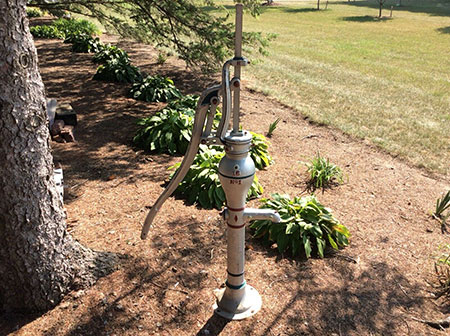
As of 2015, the average American uses approximately 82 gallons of water per day, which can be taken for granted. Most people expect water to be available at all times without considering what their lives would be like without easily accessible water sources. The Conservation Institute estimates that 1.7 billion people in the world live off the grid, which means being self-sufficient and not using any utilities or other modern-day conveniences. That number increases each year.
To achieve this independence, electricity must be on-site and powered by renewable energy sources if possible, such as solar, wind or geothermal. Backup/emergency power via generators and fuel reserves should also be on hand. Many people simply do without electricity. However, doing without water is not an option. Those living off the grid must have a water source such as a well, spring, stream or nearby lake. The means to extract/pump the water for its intended use is vital.
People living without a convenient water source must travel to obtain and transport what is needed. There are several options available to draw water from existing natural resources.
Lever-Operated Manual Well Water Pumps
Lever-operated manual well water pumps are an option for established communities that makes transferring the water into a portable container relatively easy.

How lever-operated manual well water pumps work
The manual water pump is a device that works thanks to a piston or plunger, a lever attached to a moving point, a connecting rod and a washer. As the hand pump lever is raised, the piston goes down and the water enters through the holes or tubes in the pump body and the washer is lifted by the pressure of the water. A suction effect is created by this action. When the lever is lowered, the washer does the same, cutting off the flow of water and causing it to accumulate inside the pump. When the process is repeated a few times, the amount of water that accumulates in the pump increases and eventually flows out of the outlet valve with each stroke.
Advantages
The manual water pump is typically dependable and durable. It is operated with minimal strength or effort and is easy to service. It is also inexpensive and self-priming.
Disadvantages
A well is needed for operation. The pumps work best with an extraction pipe diameter of 4 inches with a depth based on underground water level. Depending on the area and cost, a well may not be a viable option. Also, hand-operated water pumps are not portable in most cases.
Solar Powered Water Pumps
Solar-powered water pump usage is becoming increasingly popular. The cost of a low-maintenance solar pumping system may make sense compared to the cost of a generator to run a typical water pump, with continual fuel and maintenance costs. A good solar pumping system is often more economical, which is why many nonprofits use solar pumping to provide clean water to remote communities around the world.

How solar-powered pumps work
Solar-powered photovoltaic solar panels produce electricity from sunlight using silicon cells, with no moving parts. Low volume pumps use positive displacement (volumetric) mechanisms that seal water in cavities and force it upward. Lift capacity is maintained even while pumping slowly. These mechanisms include the types used in diaphragm, vane and piston pumps.
Advantages
These pumps are becoming more affordable. Modern systems are reliable and most are easy to service. Many options are available depending on required flow rates, and the technology continues to improve.
Disadvantages
They are not easily portable in most cases, especially with required solar panels. Cost can still be prohibitive depending on the system required. Solar pumps work best in full sun. As a result, performance will decrease significantly in low light before turning off. With use in low-light, a battery may be required, further impeding portability and raising costs.
Portable Impeller Pumps
Portable impeller pumps in various forms have been used for years to handle everything from small jobs around the house to fluid transfer in an industrial setting. They are available with alternating current (AC) or direct current (DC) motors and can also be operated with a variety of different drills, including rechargeable, depending on how remote the application may be.
How portable impeller pumps work
A flexible impeller with five or more impeller blades applies pressure to the inside of the pump housing. A shaft with a key runs through the center of the impeller. The shaft is powered via drill or remote power source. The positive displacement rotating impeller transfers the liquid from the inlet to the outlet port of the pump.
.jpg)
The design allows for dry self-priming and discharge pressures up to 60 pounds per square inch (psi), which equates to a travel distance of over 100 feet of hose. Depending on the manufacturer, reliable versions are offered in housing materials from aluminum to stainless steel and impellers are offered in Food and Drug Administration (FDA) approved elastomers if required.
Advantages
These pumps are designed to be portable. The compact lightweight pump and a rechargeable drill can be carried anywhere the user chooses/is able to travel via a tool belt or carry case. The pump can be carried in a user’s pocket. Depending on the model, they are able to self-prime with water up to 14 vertical feet and develop pressures high enough to move water over 100 feet through hose if needed. This is useful when transferring water from a creek with a steep embankment or to a larger container on a bank uphill from a water source.
A portable impeller pump has shallow well water transfer capacities up to 16 gallons per minute (gpm).
They are durable and easy to service depending on the brand, and the most cost-effective remote water pump option listed in this article. They can be powered by most standard rechargeable drills and are the most straightforward way to provide potable water without cumbersome equipment in a variety of circumstances.
Disadvantages
It requires a rechargeable battery power source to operate. A portable drill must be held to operate properly in most cases. It requires a short-length suction hose. Suction lift is no more than 14 feet from ground level.
There is an increasing need worldwide for off-grid pump systems. The reasons for this range from economic factors and population growth to those who want to purposely reduce their carbon footprint and remove themselves from risks involved with living in more densely populated areas. The requirement for clean water has also increased due to the need for proper sanitation in today’s world. Remote communities are at higher risk of disease transmission without an accessible clean water supply.
The pump options listed only consider the ability to transfer water. They do not include filtration that may be required based on the water source and its intended use.
References
infoplease.com/math-science/earth-environment/living-off-the-grid

